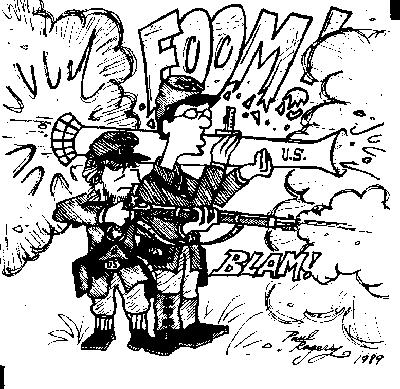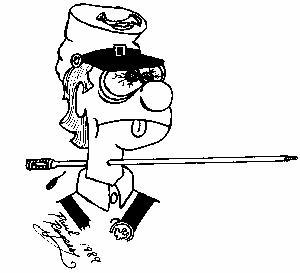Ten Safety Tips
by Jonah Begone - Illustration by Paul Rogers
Heaven knows I don't like setting myself up as yet another Black Powder Expert, but in the interest of a safe and happy reenacting hobby I wrote this anyway! Please read and heed.
 1. MAGNUM ROUNDS ARE UNCOOL. No one can pick out your individual
shot in company and battalion firing anyway, so why waste the
powder? (And if they can, you might get the reputation for being
a fool and neither you nor your unit needs that kind of
attention, thank you.) 60 grains 2Fg is the standard load for
National Park Service weekends. Please fight the temptation to
use more than 80 grains 2Fg elsewhere.
1. MAGNUM ROUNDS ARE UNCOOL. No one can pick out your individual
shot in company and battalion firing anyway, so why waste the
powder? (And if they can, you might get the reputation for being
a fool and neither you nor your unit needs that kind of
attention, thank you.) 60 grains 2Fg is the standard load for
National Park Service weekends. Please fight the temptation to
use more than 80 grains 2Fg elsewhere.
2. CLEAN OUT THAT BARREL! Why? Because there is a direct relationship between the dirtiness of the inside of your barrel and the possibility of a "cook-off." If you don't do a thorough job of cleaning out the black powder goo that accumulated from the last event, after a shot or two sparks can reside therein and give you an unpleasant surprise when you next pour powder! By the way, remove the barrel from the stock when you clean - you'll do a better job.
3. GET ON LINE WHEN NOT FIRING IN RANKS! "On line" means that you're firing directly between the guys positioned behind the fence, trees or whatever you're firing from; not a foot or two in front and certainly not an inappropriate distance behind. ("An inappropriate distance behind" is anything that is not having your rifle over a man's right shoulder, with his head positioned safely between the second and third bands of your rifle.)
4. AVOID A SLOPPY "RIGHT SHOULDER SHIFT" you know, when you're not keeping the butt end of your rifle snug against the upper part of your chest. What happens - and you can't see it - is that your rifle barrel threatens to bop the guy behind you. This can be a real problem when you're loaded, in "company front" and running. The guy behind you is then looking right down your barrel. Not a reassuring sight. (Note: if your right shoulder shift is comfortable, you're probably not doing it correctly!)
5. GET SOME FIRING SPACE BETWEEN YOU AND THE ENEMY! Obviously. They already greatly outnumber us Yanks; why make 'em mad? Give it 50 yards at the closest, and then elevate your musket.
6. THE DEFINITION OF A COMBAT "SAFE" MUSKET: AT THE HALF-COCK, CAP OFF NIPPLE. If you don't know that you'll fire sometime real soon, do this. Your half-cock can be tested by supporting your rifle's weight upside down by the trigger; it passes if the hammer doesn't release to strike the nipple. And never run around with the hammer down onto an unexploded cap - you could drop the rifle on its hammer and have it go off.
7. NEVER FIX BAYONETS IN A BATTLE. And if some idiot tells you to, ignore them.
8. DISCHARGE WEAPON BEFORE TAKING A HIT. You can never tell where that thing will end up pointing to (could be your face), and one good kick could set it off. Then you'd really take a hit!
 9. NEVER USE YOUR RAMROD IN A BATTLE. The reasoning here is that
you could get frenzied and careless with the realism of it all
and accidentally send your ramrod flying into someone (it has
happened). Even if you're the cool type, other guys can see you
ram and get nervous about it, and once again, your unit probably
doesn't want that kind of publicity.
9. NEVER USE YOUR RAMROD IN A BATTLE. The reasoning here is that
you could get frenzied and careless with the realism of it all
and accidentally send your ramrod flying into someone (it has
happened). Even if you're the cool type, other guys can see you
ram and get nervous about it, and once again, your unit probably
doesn't want that kind of publicity.
10. DON'T USE A NIPPLE PICK WHEN LOADED. You could ignite the powder charge when your rifle is pointing somewhere you rationally wouldn't want it to. Don't believe me? I saw it happen! (And if when you're firing the powder charge doesn't go off, re-cap and try again. If you're still firing duds, dump powder and then pick.)
That's it for now. Let's remember these kindly little hints and watch out for one another, okay?
